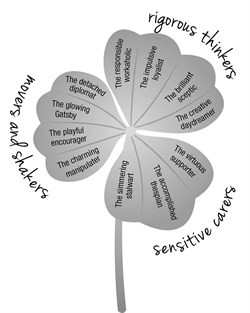What "type" of leader am I?
05 September 2014
![]()
 On hearing about the publication of our forth coming book "the leadership shadow” a group of senior executives immediately asked the question "are we in it?"
On hearing about the publication of our forth coming book "the leadership shadow” a group of senior executives immediately asked the question "are we in it?"
Most executives and leaders are curious about how they come across to others. Often the first question you hear asked about anyone taking up a leadership role is "what kind of leader is she?
Human beings are very complex. It is not useful to label all their possible complex behaviours in narrow simplistic ways. However much work has now been done to categorise and describe the wide ranging patterns of behaviours, preferences, ways of relating, learning styles, drivers, personality factors, responses to stress , and motivational factors that people associate with.
In our recently published book “The Leadership Shadow” we examine and refer to some of the ways you can inquire into and understand better the leadership patterns you may recognise.
We present a typology of 11 distinct patterns experienced when executives go into relational myopia and overdrive. This typology is based on observations of executives built on clinical descriptions of character described by psychiatrists and can be found in medical manuals [DSM-IV] (American Psychological Association 1994).
If you are an executive keen to understand better how others experience you, you may recognise some of your own patterns and the patterns of others around you in these descriptions. It may be useful for you to reflect on when and how these patterns are helpful and productive and when and how they become unhelpful and counter-productive.
.
Summary Overview Description of Patterns
(Please note this is a very high level summary description and more detail and information and case examples are presented in the book and other associated references)
Movers and Shakers - Patterns that focus on action or (paradoxically) actively withdrawing from (productive) action
- “The Charming Manipulator”- which we have linked to ‘anti-social’ characteristics - moves to charm and dazzle you and to engineer a very impressive performance.
- “The Playful Encourager” - which we have linked to ‘passive-aggressive’ characteristics - moves to encourage others and find encouragement, being both sensitive to motivation and reluctant to act when not motivated.
- “The Glowing Gatsby” - which we have linked to ‘narcissistic’ characteristics - moves to propel him- or herself forward into a glorious future, impressing everyone around them.
- “The Detached Diplomat” - which we have linked to ‘schizoid’ characteristics - distinguishes him- or herself by not being moved in those occasions where other people would be: their main characteristic is a stoic, tough or detached form of ‘non movement’.
Rigorous Thinkers: Patterns which are related to the leader’s cognitive style or way of thinking:
- “The Responsible Workaholic” which we have linked to ‘obsessive-compulsive’ characteristics - ruminates about his every action and doggedly carries it out with rich detail and self-monitoring.
- “The Impulsive Loyalist” - which we have linked to ‘borderline’ characteristics - ruminates in a more excited way, vacillating between optimism and pessimism.
- “The Brilliant Sceptic” which we have linked to ‘paranoid’ characteristics - is a critical thinker, full of suspicions about other people’s motives.
- “The Creative Day Dreamer” which we have linked to ‘schizotypal’ characteristics - is a creative thinker with endless supplies of great ideas that however rarely get executed.
Sensitive Carers: three Patterns related to the leader’s care and attention to emotion and feeling.
- “The Virtuous Supporter” - which we have linked to ‘dependent’ characteristics - feels for other people and wants to be a good team player for them.
- “The Accomplished Thespian” which we have linked to ‘histrionic’ characteristics - overflows with feeling, particularly their own private feelings.
- “The Simmering Stalwart” which we have linked to ‘avoidant’ characteristics - also overflows with feeling, but more in a concerned and troubled sort of way.
In the book “The Leadership Shadow”” we describe classic patterns of derailment and offer help to discover how these patterns may show up and you might assess how these patterns may be relevant to you.
After learning about a range of leadership patterns or subclinical personality traits you may wish to inquire further into your own patterns as a leader or to get professional executive coaching support and assistance to do so. One of the inventories we mention in the book is the Hogan Development Survey (Hogan & Hogan, 1997. You can find out more about it and how to find a qualified consultant who has a Hogan Development Survey accreditation.at www.hoganassessments.com
This blog article is adapted and edited from the Book by Prof Erik de Haan and Dr Anthony Kasozi, The Leadership Shadow, published August 3rd 2014; available from www.koganpage.com
Read Other Thought Pieces